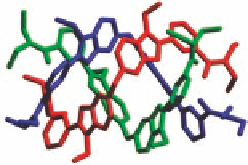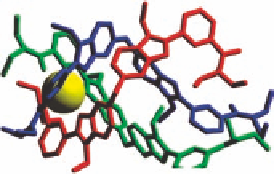Chemistry Reference
In-Depth Information
Δ
G
preorg
[
L
3
]
M
3+
+ 2
M
3+
Δ
G
complex1
+
M,R
Δ
G
f
= −
RT
ln
β
2,1
M
3+
+
Δ
G
complex2
M,M
Δ
E
1-2
M
M
M
k
N6O3
k
N6O3
k
N6O3
Figure 3.15 Self-assembly of double-stranded helicates. The preorganization of the receptor
followed by successive intermolecular metal binding is associated with the site-binding mod-
els for each microspecies.
Adapted with permission from [48]. Copyright 2004 American
Chemical Society.
analysis of monostranded helicates. The obtained microscopic parameters can be further
applied for predictions of polynuclear topologies, where different metal ions are bound
along multisite receptors. These problems concerning large assemblies can be advanta-
geously treated using transfer matrix techniques, which allow the prediction of binding
isotherms, and the receptor's microstates or occupancy [16]. Finally, the model of a virtu-
ally preassembled receptor has also been adapted for analysing cooperativity in supra-
molecular systems [41].
3.5.2.2 Thermodynamic Additive Free Energy Model
In order to escape the number of limitations connected with the site-binding model and
statistical repetitive binding, a considerable effort was devoted to the development of an
universally valid thermodynamic description of multicomponent self-assembly processes.




























































Search WWH ::

Custom Search